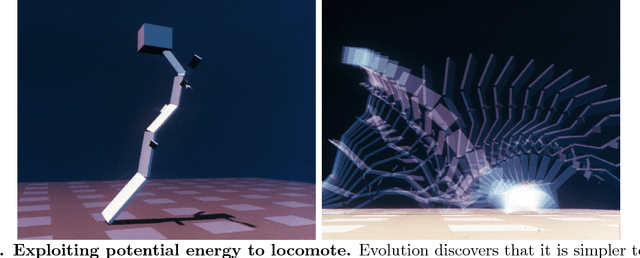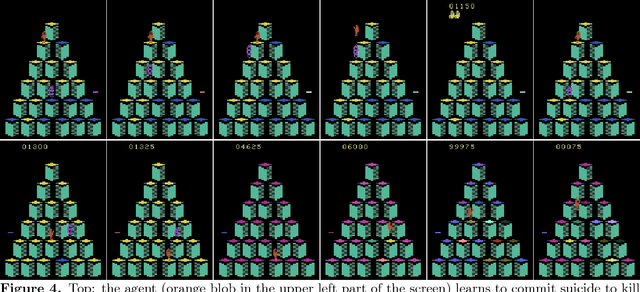Westley Weimer
Self-Organization in Computation & Chemistry: Return to AlChemy
Aug 23, 2024Abstract:How do complex adaptive systems, such as life, emerge from simple constituent parts? In the 1990s Walter Fontana and Leo Buss proposed a novel modeling approach to this question, based on a formal model of computation known as $\lambda$ calculus. The model demonstrated how simple rules, embedded in a combinatorially large space of possibilities, could yield complex, dynamically stable organizations, reminiscent of biochemical reaction networks. Here, we revisit this classic model, called AlChemy, which has been understudied over the past thirty years. We reproduce the original results and study the robustness of those results using the greater computing resources available today. Our analysis reveals several unanticipated features of the system, demonstrating a surprising mix of dynamical robustness and fragility. Specifically, we find that complex, stable organizations emerge more frequently than previously expected, that these organizations are robust against collapse into trivial fixed-points, but that these stable organizations cannot be easily combined into higher order entities. We also study the role played by the random generators used in the model, characterizing the initial distribution of objects produced by two random expression generators, and their consequences on the results. Finally, we provide a constructive proof that shows how an extension of the model, based on typed $\lambda$ calculus, could simulate transitions between arbitrary states in any possible chemical reaction network, thus indicating a concrete connection between AlChemy and chemical reaction networks. We conclude with a discussion of possible applications of AlChemy to self-organization in modern programming languages and quantitative approaches to the origin of life.
Automated Program Repair: Emerging trends pose and expose problems for benchmarks
May 08, 2024Abstract:Machine learning (ML) now pervades the field of Automated Program Repair (APR). Algorithms deploy neural machine translation and large language models (LLMs) to generate software patches, among other tasks. But, there are important differences between these applications of ML and earlier work. Evaluations and comparisons must take care to ensure that results are valid and likely to generalize. A challenge is that the most popular APR evaluation benchmarks were not designed with ML techniques in mind. This is especially true for LLMs, whose large and often poorly-disclosed training datasets may include problems on which they are evaluated.
Genetic Improvement @ ICSE 2020
Jul 31, 2020

Abstract:Following Prof. Mark Harman of Facebook's keynote and formal presentations (which are recorded in the proceedings) there was a wide ranging discussion at the eighth international Genetic Improvement workshop, GI-2020 @ ICSE (held as part of the 42nd ACM/IEEE International Conference on Software Engineering on Friday 3rd July 2020). Topics included industry take up, human factors, explainabiloity (explainability, justifyability, exploitability) and GI benchmarks. We also contrast various recent online approaches (e.g. SBST 2020) to holding virtual computer science conferences and workshops via the WWW on the Internet without face-2-face interaction. Finally we speculate on how the Coronavirus Covid-19 Pandemic will affect research next year and into the future.
The State and Future of Genetic Improvement
Jun 27, 2019Abstract:We report the discussion session at the sixth international Genetic Improvement workshop, GI-2019 @ ICSE, which was held as part of the 41st ACM/IEEE International Conference on Software Engineering on Tuesday 28th May 2019. Topics included GI representations, the maintainability of evolved code, automated software testing, future areas of GI research, such as co-evolution, and existing GI tools and benchmarks.
The Surprising Creativity of Digital Evolution: A Collection of Anecdotes from the Evolutionary Computation and Artificial Life Research Communities
Aug 14, 2018



Abstract:Biological evolution provides a creative fount of complex and subtle adaptations, often surprising the scientists who discover them. However, because evolution is an algorithmic process that transcends the substrate in which it occurs, evolution's creativity is not limited to nature. Indeed, many researchers in the field of digital evolution have observed their evolving algorithms and organisms subverting their intentions, exposing unrecognized bugs in their code, producing unexpected adaptations, or exhibiting outcomes uncannily convergent with ones in nature. Such stories routinely reveal creativity by evolution in these digital worlds, but they rarely fit into the standard scientific narrative. Instead they are often treated as mere obstacles to be overcome, rather than results that warrant study in their own right. The stories themselves are traded among researchers through oral tradition, but that mode of information transmission is inefficient and prone to error and outright loss. Moreover, the fact that these stories tend to be shared only among practitioners means that many natural scientists do not realize how interesting and lifelike digital organisms are and how natural their evolution can be. To our knowledge, no collection of such anecdotes has been published before. This paper is the crowd-sourced product of researchers in the fields of artificial life and evolutionary computation who have provided first-hand accounts of such cases. It thus serves as a written, fact-checked collection of scientifically important and even entertaining stories. In doing so we also present here substantial evidence that the existence and importance of evolutionary surprises extends beyond the natural world, and may indeed be a universal property of all complex evolving systems.
 Add to Chrome
Add to Chrome Add to Firefox
Add to Firefox Add to Edge
Add to Edge